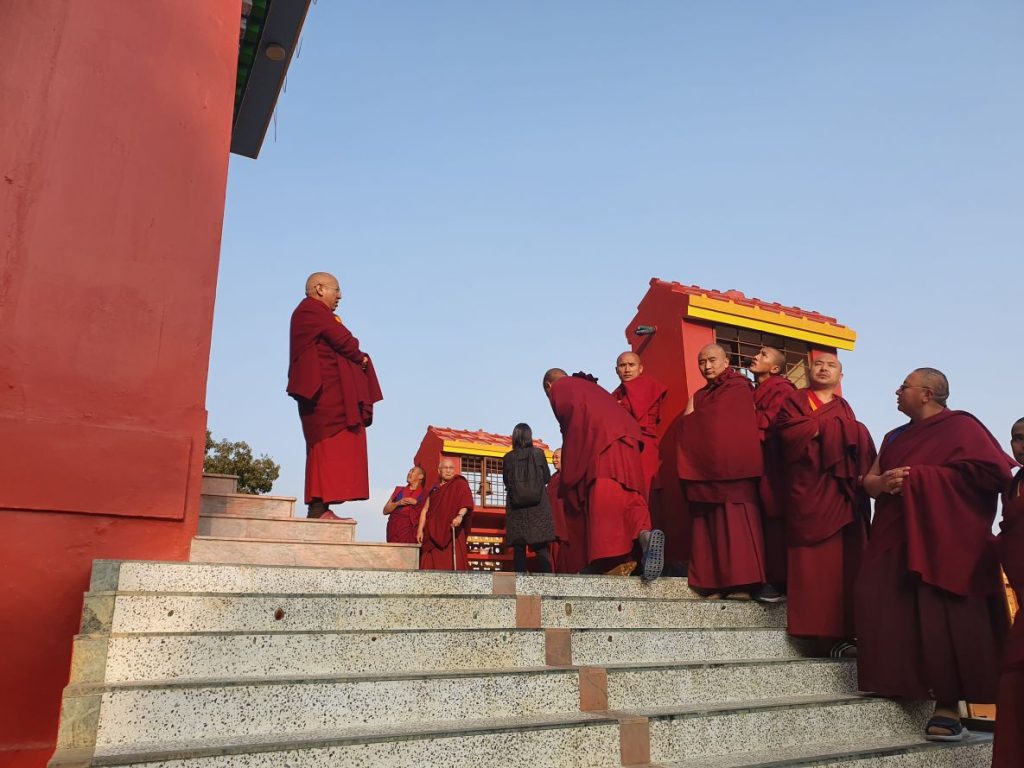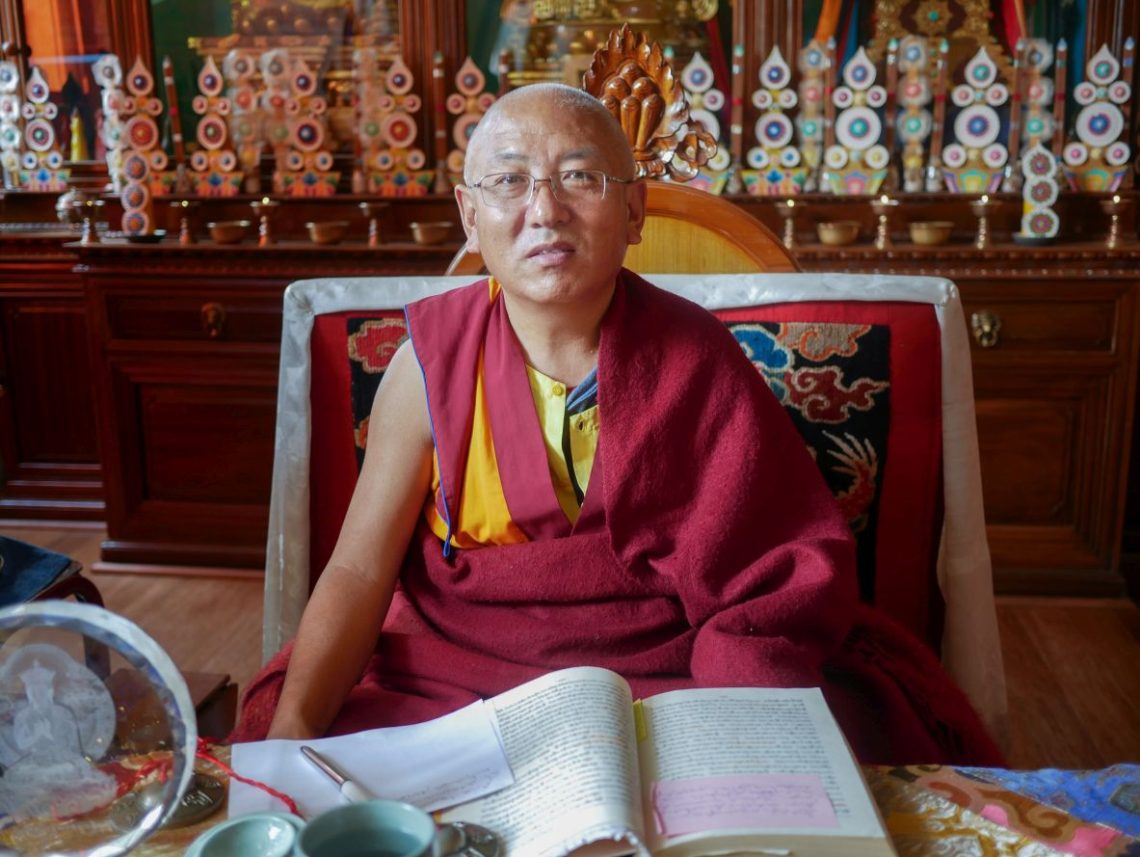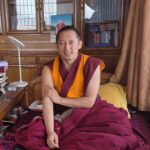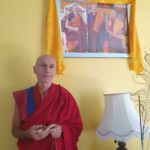“Gyalwa Chaktri is an experiential text. Its author, Dru Gyalwa Yungdrung, describes stages in his own practice which led him to a full realization – and the manual begins with the Ngondro,” Ponlob Tsangpa Tenzin Rinpoche says, to emphasize the importance of the preliminary practices in Dzogchen. Gideon Makin, the editor of Rinpoche´s book about the preliminary practices published last year by Vajra books, kindly agreed to present our questions about the Ngondro to Rinpoche on the occasion of his teaching at Shenten in May 2022. Khenpo Gelek Jinpa kindly agreed to be a translator of the interview.
—
Dzogchen teaching says that the Dzogchen meditation on the natural state is the most powerful way to purify one´s mind and to remove afflictive emotions. It is said to be one medicine for one hundred diseases. Rinpoche, how would you explain to the Western students of Dzogchen that even if this is true, the preliminary practices should not be neglected? To them, they might seem less effective and harder to do.
Yes, the Western students sometimes come to me and say that they do not like the Ngondro much and do not find the will to practice it. They love Dzogchen, they say, but they do not like the Ngondro. This attitude is mistaken. In Dzogchen, there are three different categories of practitioners, depending on their capacity: practitioners of the highest capacity, of the medium capacity and of the least capacity. Those who fall in the first and second class do not need to practice the Ngondro. But those practitioners are rare, among one thousand people you can find not more than one. The vast majority of practitioners fall into third class and need the preliminary practices which are the key to the Dzogchen practice. Ngondro is like a pot which contains an essence – the Dzogchen practice. It is like a foundation of the house. Ngondro is very, very important.


Gyalwa Chaktri, the commentary and practice manual of Zhang Zhung Nyen Gyud Dzogchen cycle, was based on the author´s experience with the Dzogchen practice. It is not an intellectual construction, it is an experiential text, and it begins with the Ngondro. After practicing it, the realization of Dru Gyalwa Yungdrung developed and he moved to the practice of the fixation of the mind. After mastering it, he moved to the practice of Tregcho, and finally, he practiced Thogal. He built his realization gradually and in this way he reached his result. That´s why I really felt it was important to start my teaching in the West with Ngondro, and I am very happy that the teaching was transcribed and made into a book released by Vajra books. After it was published I received messages from the Western students saying to me that they found the book very interesting and that it made them realize the importance of the preliminary practices. I am thankful to the people who made this possible, Sangmo Yangri who translated it and Gideon Makin who edited it.
When do the monks do their Ngondro, at the monastery? They are usually very busy with their studies. Are they given a period of time for it? And is it a condition for being introduced to the main practice?
At the monastery, there are two groups of monks and two courses of studies: some monks study at the Gomdra, the meditation school, and the others study philosophy, at the Dialectic school, the Shedra. While Gomdra is experiential, the students of the Dialectical School start with Sutric philosophical texts, cosmology and close subjects, and then continue with the Vinaya – a monastic code of conduct. They also study poetry and master various rituals, over ten years of studies. In the eleventh year, before entering into the class of tantric studies, they have a fifty day retreat during which they are supposed to complete their Ngondro. They are not allowed to leave the monastery in this period and are encouraged to practice Ngondro intensively, which means to accumulate one hundred thousand repetitions of each of the nine practices. Only then are they introduced to the natural state and receive the teachings on tantra and Dzogchen which follow. The complete curriculum of studies lasts thirteen years and for some students even much longer.
Also, the students of Gomdra have to complete the Ngondro, during a four year program. Usually they are supposed to dedicate one hour a day to it, as their first activity of the day, very early in the morning. The monks receive instructions and recommendations of Yongdzin Rinpoche who always stresses the importance of the Ngondro to them. If you want really to understand Dzogchen, you have to go through the Ngondro, he says to them.
Rinpoche, if it is comfortable for you, please share with us how you approached the preliminary practices and what kind of benefits you noticed.
I did my Ngondro when I was eighteen years old and I followed the text of Kalung Gyatso of Shardza Rinpoche. It is a commentary of the Atri Dzogchen Cycle dedicated to Ngondro. And I definitely felt the impact of the practices like contemplation on impermanence or Bodhicitta on my mind. My mind was really changed, it developed devotion and trust in the teaching. The practice has a very positive effect on the mind, without any doubt.
What are you in charge for as the head teacher of the monastery?
Generally speaking, I am responsible for the education of the monks of the Dialectic school, and specifically I focus on teaching higher classes of the thirteen-year curriculum, I teach the subjects that come in the eleventh, twelfth and the thirteenth year of the studies. Monks study in different classes and I teach each group for one hour a day, which is usually three hours a day, in the morning. No tea break between the classes (Rinpoche smiles).

What is the schedule of the monks? How many hours a day do they receive the teaching?
Usually, the monks start their day at around seven o´ clock in the morning. Their schedule includes classes in philosophy, personal studies and debates till lunch. At three thirty they continue with other subjects, like poetry, for example, and they again practice philosophical debating. If they have no group program they are supposed to study or accumulate Ngondro repetitions.
For how long do the monks study each subject?
Usually for one year.
Do you also give some teachings to Tibetans who are not monks? If so, what kind of teaching do they receive and in which way?
Yes, Tibetan lay people come to the monastery on some occasions like, for example, the anniversary of the birthday of Tonpa Shenrab, and on that occasion I give them teachings, usually about the benefits of the spiritual practice, compassion, Bodhicitta, accumulation of virtues and so on.
Do you adapt the content or the style of the teaching to the lay practitioners or do you teach them in the same way as you teach monks?
The style is a bit different. With monks, the emphasis is more on philosophical reasoning. With lay people we do not need to go into these complicated things and teaching can be more direct. Also, of course it depends on whether the people I teach speak Tibetan. If they do not, I have to fill some language gap and the teaching cannot be exactly the same as when I speak to Tibetans public.
In 2020 and 2021 you could not come to Shenten due to the pandemic and instead, as did other teachers, gave your teachings online. How did you feel about it?
At the beginning, before the teaching on zoom began, I thought it would be really strange, and funny, because I was supposed to talk to people while there was nobody in the room. But when I started, surprisingly, I felt the same as usual. As if there was no difference.
Did the covid lockdowns change habits and routines in the monastery?
Monks could not go to Kathmandu due to the lockdowns. The monastery checked quite strictly, at the gate, to see that nobody goes out and so we were quite isolated from the disease and the monks focused on their studies more than usual. We kept teaching classes as usual but in general we taught more intensively, because there were less days off and no possibility of leaving on days off. I think that senior monks, at least some, appreciated that they could go deeper into their studies, with less distractions, while younger monks were more annoyed with the situation because they would have liked to have some distractions outside the monastery.
You have been coming to Shenten since 2014, with the mentioned two-year break. Is there something you like in particular about being at Shenten? And is there something that you miss, from your life in the monastery, during those visits?
What I like a lot about Shenten is that it is a very peaceful place. Kathmandu is a very noisy city and the monastery is a very lively, compared to it Shenten is an oasis of calmness and stillness. When I am in Shenten I always think: this place is really great for meditation. And I do not miss anything.
What are your other plans while being in Europe? Which places and countries are you planning to teach?
In the Netherlands, there is my teaching organized by the Tapihritsa center. I will then go to Poland, to Chamma Ling, and after that there is an invitation from Yeshe Sal Ling in Austria. After that, I will be going back to France, for a teaching in Marseille, then I will go to Paris, for the last teaching before returning to Triten Norbutse.
If you were completely free to go to any place, what would you like to see, in Europe?
I do not have any particular wish to go anywhere, to a particular place, also because I do not know much about Europe, its history, and about what are the important places to visit. Usually I travel for teaching. It is like at Shenten. I do not know places around Shenten either. It’s the same when I go to other countries. I do not usually travel around, so I do not know what I’m missing (Rinpoche smiles).
Ponlob Tsangpa Tenzin Rinpoche is the head teacher (Ponlop) of the Triten Norbutse Monastery in Kathmandu, Nepal, founded by his master, Yongdzin Rinpoche. There, day by day, Ponlob Rinpoche truly embodies Yongdzin Rinpoche’s spirit and values, dedicating himself fully to the education of “his monks,” as he calls the students of the Yungdrung Bon Academy at the monastery. His first visit to Shenten Dargye Ling (and the West) took place in 2014. Since then, Ponlob Rinpoche has returned every year – with th exception of 2020 and 2021 – and almost immediately, he earned the deep affection and respect of the western Bon students, who praise him for his pure, humble conduct and his extraordinary teaching skills.

Dear readers! If you want to be informed when we publish a new article, subscribe for news and updates on the home page. Scrolling down you will find a window where to place your email address and when you do that, our new texts will arrive to your email box.













Jarosław
September 8, 2023 — 3:57 pm
I mean older articles 😉
Jarosław
September 8, 2023 — 3:55 pm
Thank you!
I come back from time to time to older articians … always very inspiring!
Kind regards:)
Jitka Polanská
January 2, 2023 — 10:46 pm
Thank you!
Jim Duffy
January 1, 2023 — 4:53 pm
Thank you for this wonderful resource!
Beatrix Beannacht
June 1, 2022 — 3:29 pm
Thank you. I am saving to visit Shenten next year and this article was quite inspiring.